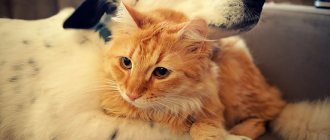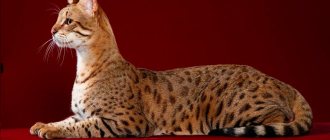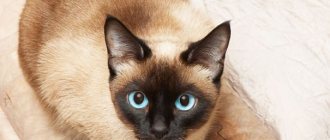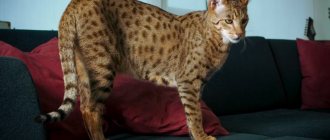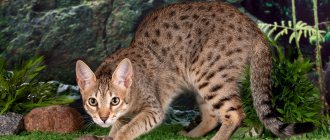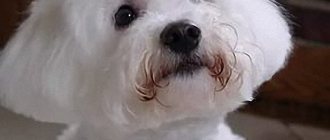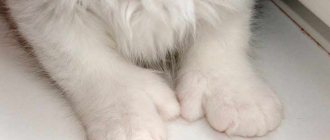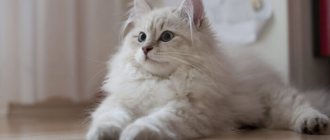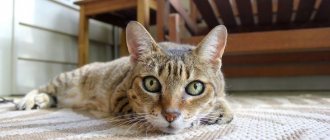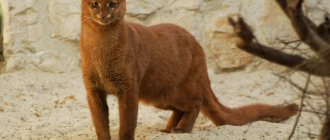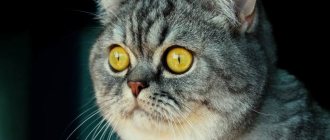The ancestor of all cats in the world was a steppe species (according to another version - a forest one), which began to be domesticated 12,000 years ago. It was from then on that selection arose, during which an animal acquired certain traits beneficial to humans and lost others. Now it is difficult to answer how many breeds of cats exist in the world, but it is possible to understand this issue.
The uncertainty in the number of breeds occurs due to the fact that there are simultaneously 3 largest felinological organizations in the world:
- WCF is the World Federation, the largest and most authoritative at the moment. It was founded in 1988 in Rio de Janeiro and has more than 540 clubs.
- FIFe is one of the participants of the World Felinological Congress. Created in 1950 in Belgium.
- TICA is an International Association, founded in 1979 in the USA, but later acquired an international format.
The main difficulty is that these organizations do not register and recognize breeds at the same time. Most often this happens over time, but sometimes a species recognized by one organization is never confirmed by others. In addition, several breeds are constantly at the stage of preparation and documentation.
Each organization applies its own criteria and parameters to determine purebredness. Most often these criteria are:
- body shape and body proportions;
- eye color;
- temperament and character;
- characteristics of wool;
- health characteristics, etc.
Currently the most varieties are registered in the WCF: about 74, 9 of which are recently registered. FIFe and TICA declare 51 and 73 varieties respectively.
Classifications
The main classifications of cat species are divided according to 4 main criteria:
- by physique;
- by coat;
- by color;
- according to the drawing.
By physique
According to this parameter, cats are divided into 6 main groups:
- Animals with a powerful physique (heavy type). These include the largest representatives. They have the thickest and strongest tail, powerful stable paws and a large short neck. Typical representatives are Maine Coons or Siberian cats.
- Kobby (stocky). They have a dense and stocky build. The skeleton is characterized by a wide chest, a large head with a short and wide nose is placed on a shortened neck, which sometimes seems almost absent. Usually the paws are not very high, and the tail is short with a blunt end. An example would be exotics or Manx.
- Oriental. They have a graceful structure with high paws. There is a graceful neck and a narrow long tail. The head and muzzle are always tapered towards the nose. Typical Orientals are Javanese and Balinese cats, as well as Siamese cats.
- Foreign. Flexible body with pronounced muscles. High paws and long tail, wedge-shaped head, oval or almond-shaped eyes. Ears may be elongated. The Abyssinians serve as an example.
- Semi-foreign. Those with average parameters are more common than others. Representatives are American Shorthairs or Russian Blues.
- Half-cobby. Slightly stockier breeds than the previous type. A typical representative is the British Shorthair.
By coat
According to this parameter, cat breeds are divided into 5 varieties:
- long-haired with hair up to 15 cm long (Burmese, Siberian, Persian cats);
- shorthair (Egyptian Mau, Chartreuse, Russian Blue);
- curly coat (German Rex, Cornish Rex);
- Wirehaired (American Wirehair);
- without wool (, bambino, sphinx).
By color
There are a huge number of colors, but they are all divided into the following main types:
- single-color (korat, havana);
- two-color (Norwegian forest, ragdoll);
- motley (color-point, angora);
- with specks (Persian chinchilla or American shorthair cat);
- multi-colored or tortoiseshell (bobtail, sphinx, Persian).
According to the drawing
The main variants of patterns that form the breed:
- solid pattern (red, black, brown, gray, etc. breeds);
- zonal color (striped, marbled or spotted tabby);
- white spotting (mostly a whole color with spots of different colors);
- solid white;
- color-point (light body and dark limbs);
- silver (smoky, silver, chinchilla and cameo).
Some of the drawings can be viewed in the gallery:
How are breeds classified?
Each organization has its own characteristics and takes into account certain parameters. The most commonly used:
- body shape, proportions;
- health characteristics, tendency to certain diseases;
- character and temperament traits;
- characteristics of wool, its length and color.
The most numerous organization for cat breeds is the WCF organization. According to its data, there are 74 species, in FIFe - 51 and in TICA - 73.
Description of the main breeds
The main types of cats were derived from the earliest, but not always the most widespread, breeds. And now breeders continue to experiment with these species, achieving new results.
- British.
They became the founders of two main lines: British Longhair and Shorthair, the older of which is the Shorthair. Both species are characterized by ideal hair, which is very easy to care for: it does not mat and does not shed as actively as other representatives of the cat world. - .
Their color resembles wild rabbits, which is why they got their first name - “rabbit cats”. Very easy-going, with a good disposition and graceful body. - Scottish.
There are 2 main forms - straight-eared and lop-eared. The basic one was straight-eared, and lop-eared was the result of genetic experiments, during which it was possible to fix the gene responsible for the regression of cartilage tissue. - American Curl.
The main distinguishing feature is the ears, which bend inward or backward at different angles. The inner surface of the auricle is densely pubescent. American Curls are very active animals; their playfulness and activity remain in them until old age. - European Shorthair.
Experts believe that this breed was formed with minimal human intervention. It is quite difficult for a non-professional to distinguish these cats from ordinary yard cats, since they are as close as possible in genotype and appearance. - Angora.
There is an opinion that she became the predecessor for all long-haired pedigree groups. A distinctive feature is the absence of undercoat and a thick collar around the neck. - Egyptian Mau.
Of all the species currently known, the Mau is the most ancient. Her image was first drawn 3 thousand years ago. Her eyes look very unusual: they seem to be lined with eyeliner, and a “W” pattern is visible between her ears.
It is not possible to count all the cats living on Earth, if only because they constantly reproduce and die. With long or short hair, large or small, with a round or wedge-shaped muzzle, with or without a tail - each variety includes an innumerable number of individuals. From the article we will find out how many cats there are in the world: wild, domestic and purebred.
Characteristics of cat breeds
Each breed has its own characteristics, behavior, and habits. Of course, almost all cats can be raised and trained, gradually adapting to the rules established by humans. However, some people get used to it easier, while others require a lot of work. It depends on the character.
The most affectionate cats
Affectionate breeds of cats are very loved by their owners for their tenderness and purring; they happily greet a person from work, lie on their laps for a long time or wake them up by purring softly in the ear. Such displays of love, and sometimes even care, can be expected from the following breeds:
- bambino;
- British Longhair;
- Burmese;
- Nibelung;
- chausie;
- Chartreuse (Carthusian);
- ragamuffin.
These breeds have a soft, calm character, and sometimes even phlegmatic. Even a small child can play with them without fear of getting scratched. And manifestations of aggression are completely atypical for them and rather an exception to the rule.
Bambino cat.
British blue longhair cat.
Burmese cat.
Nibelung cat.
Chausie cat.
Ragamuffin cat.
Carthusian Chartreuse cat.
Cats similar in character to dogs
Sometimes it is difficult for a family to get a dog for a number of reasons, but it is worth looking for cats with similar characters and habits. They have a proud, independent disposition, are loyal, and very affectionate. Among these, it is worth highlighting the Bengal one. In terms of the degree of love and affection for their owner, they can compete with the smartest dogs. The Tonkinese cat has the same features.
Bengal cat.
Tonkinese cat.
A Turkish Angora dog may notice. She will become a real four-legged friend. She likes to communicate with a person, play with him, even dog games, she is very talkative. They are well trained and follow commands. Usually, among all family members, they distinguish their owner, which makes them very similar to dogs.
Black and white Angora cat.
Savannah can also be a good substitute for a small dog; they like to spend a lot of time outside. Savannah is a mixture of an ordinary domestic cat and a serval, so do not forget about the complex character, which is explained by the presence of wild animal genes.
Savannah plays ball.
The most evil and harmful cat breeds
Typically, a person who wants to get a cat at home wants to see an affectionate pet purring gently on his lap. However, for some cat breeds, this behavior is the exception to the rule. It’s difficult to call them unequivocally evil. Rather, a peculiar character is taken for malice. Difficult temperament and natural harmfulness are most often observed in the following:
- Siamese;
- Mekong Bobtail;
- savannah.
These cats look like cute fluffy creatures, but sometimes the aggressive habits of their distant wild ancestors awaken in them. Sometimes it is difficult for a person to cope with such animals. You should definitely not leave small children alone with them, as they may cause scratches or bites. Neighborhood with domestic rodents and birds can also end badly - the hunter’s instinct will push the animal to go after easy prey.
Top 5 smartest cat breeds
There are a variety of intelligence ratings, one of the most interesting was presented by the Animal Planet TV channel. Journalists, together with scientists, studied the mental abilities of many breeds, and based on the analysis, the smartest cats were determined.
- Sphinx. These cats are able to sense the mood of their owner, are well trained and with effort, they can be taught even complex commands. You should not punish these pets; they have a very sensitive and vulnerable psyche and can become stressed or depressed.
- Siamese-oriental group. This includes Balinese, Bengal, Siamese and other Southeast Asian breeds.
- Munchkin. One of the smallest breeds, but its miniature size harmoniously merges with great mental abilities. These cats are very playful, curious, and affectionate. One of their peculiarities is the desire to hide the objects he likes in secluded places in the apartment.
- Norwegian forest. They have large size, good character, and developed intelligence.
- Maine Coon. The adult individual has an easy-going character, is active and very intelligent.
Such ratings are conditional in nature, since any breed has its “smart guys” and “bad students.” The mental abilities of a yard mongrel cat, whose upbringing has been given a lot of attention from an early age, can significantly exceed its eminent counterparts.
Don Sphynx kittens.
Oriental cat.
Munchkin cat.
Norwegian Forest Cat kittens. Maine Coon cats.
Which cats are the best mousecatchers?
Experts consider outbred cats to be the best hunters. This is fair, since hunting ensures their existence. Genes provide continuity of hunting instincts, as well as physical strength and endurance.
As for purebred cats, it is worth paying attention to aboriginal breeds that were formed by natural conditions, that is, without human intervention in these processes. The Kurilian Bobtail, Russian Blue, and Maine Coon are especially distinguished by their developed skills. Oriental cats, Abyssinians, Thais, and Siamese have good ability to catch mice.
Russian blue cat breed.
Abyssinian cat.
Thai cat color.
Wild cats
It is also impossible to determine how many cats are in the wild on planet Earth. Their representatives live on all continents except Antarctica. Some species have fully adapted to being close to humans. Thus, the lynx totals about a million individuals in the world. But some cat populations are dying out before our eyes, despite constant offspring, and therefore it is difficult to say exactly how many cats there are on earth. This is due to human activity and environmental degradation.
There is such data on endangered species
.
- lion - currently lives less than 20 thousand;
- cheetah - less than 15 thousand;
- tiger - no more than 6 thousand;
- Asian leopard - approximately 100 individuals;
- snow leopard - a snow leopard with the most beautiful fur in the world - less than 100 individuals;
- white lion - several dozen.
Now we come to the main point!
Only larger organizations that unite clubs can determine whether a new breed is officially recognized or not. This is how new cat breeds are created.
Associations determine whether the number of individuals of a new breed is sufficient to recognize the breed. Monitors compliance with the breed standard and the correctness of its description. And all questions regarding exhibitions (can it be held, when, where, start time, order of holding) are also in the hands of associations.
Now we have figured out how new breeds are officially recognized. It would seem that there should be nothing complicated further: we take all the known old ones, add registered new ones to them - and we have a complete list of breeds. But it was not there! The main difficulty is that there are a lot of organizations responsible for the standard. This includes about ten well-known international associations, such as WCF or CFA. And smaller regional ones.
Plus there are organizations built on outright deception: they do not care about quality issues, they are only interested in the money that can be collected from gullible newcomers! And for all these associations the number of breeds registered is different.
Therefore, it is impossible to say exactly how many cat breeds there are currently. About 70 are registered with WCF.
It must be remembered that breeding new breeds is painstaking work carried out by professional breeders. Do not fall for the tricks of scammers: if you want to purchase a purebred animal, carefully check the clubs, documents, and study the breed standard.
There are countries where cats are more popular, and others where dogs are more popular. Russia belongs to the first group, because according to Dalia Research, 59% of families keep cats at home. But the World Atlas Geographical Service once decided to calculate how many cats there are in the world, and it succeeded.
In total, according to statistical data, about 600 million cats live on our planet, but only 200 million of them are domestic cats. Some people get pets for religious reasons, some use them to fight rodents, and some he just can’t get past the fluffy little ball and takes it home. In 2020, a list of the 10 most “catty” countries was compiled.
USA
According to the World Atlas, about 76.5 million cats live here. Every third family has furry pets, and many do not limit themselves to just one animal. Having 2-3 cats in the house is considered the norm for Americans. They do not chase the breed and often take pets from animal shelters or from the street. In this country, it is customary to give kittens as gifts for the holidays, and according to statistics, only 3% of them are elite breeds.
China
Despite the terrible tradition of killing and eating cats (their meat is considered a delicacy in the southern provinces), China ranks second in popularity of these animals. There are about 53 million cats in the country. Residents easily take them from the street, from shelters, and at the same time just as easily part with them if they are tired of the pet. The number of homeless people grows exponentially every year, which is why in recent years organizations have been registered in China to protect animals from the tyranny of people. Even at the state level, humanitarian programs have already been developed to combat vagrants.
Russia
Local experts tried to calculate how many cats live in Russia, and their data turned out to be much more interesting than the world’s: 30 versus 12.5 million. In Russia, cats are ahead of even dogs: 37 versus 30%. Every third family gets a pet: 2/3 of them take a kitten from the street, and 1/3 from nurseries. Every year, cat shelters are opened in cities and towns: this is how the state and volunteers fight the growing number of homeless people. Our breeders even developed a new breed - Russian Blue.
Brazil
Shared 4th place with the Russian Federation, 12.5 million cats were counted here. The data is approximate and is based on an analysis of sales of pet food and pet accessories. Over the past 10 years, there has been a real boom in cats in Brazil, with sales of cat products increasing by 37% every year. If we compare the same data with Russia, then we can say with confidence that in our country there are more pets than street cats.
France
In Old Europe, cats were valued not as pets, but as a fashion accessory. Even a black cat was chosen as the symbol of this country. Perhaps France is the only state where it is possible to accurately count the number of pets, because each animal must be registered in the national database. He is given a microchip or a stamp indicating information about the owner. According to the World Atlas, the French raise 9.5 million cats.
Italy
This country does not lag behind France, but people’s attitudes towards cats are radically different. Love rules here: there is no registration, every family has at least two cats, and people take patronage over stray animals. Complete freedom - this is the principle by which animals live in Italy. They are not kept in shelters, but simply fed and released into the wild; the cats are not denied access to shops and cafes.
Great Britain
The number of cats in Britain is 7.75 million animals. This country has a law on the protection of pets, and the increase in homelessness is carefully monitored, because almost 85% of kittens in England are born “outside the plan.” State shelters are being opened and volunteer programs are being financially supported. To reduce the number of stray cats, sterilization measures are being implemented.
Germany
The Germans adore cats no less than the British; in this country, the Geographical Society also counted 7.7 million cats. Here the animals are surrounded with special love: they are bought expensive food, expensive accessories, and walked on a leash, like dogs. At the same time, the problem of homeless animals remains: the authorities were forced to introduce a ban on the free walking of uncastrated cats in order to prevent their uncontrolled reproduction.
Ukraine
There are 7.5 million cats in this country, half of them are domestic, elite or simple mousecatchers, the rest are strays. Protection of the rights of the latter is absolutely not ensured at the state level, there is no punishment for throwing pets onto the street, the opening of shelters remains only the work of volunteers.
Japan
It is very strange that the Land of the Rising Sun was in 10th place in the World Atlas ranking, because there is a cat temple and even cat islands. Cafes and salons for furry pets are opening. The cat population is 7.2 million.
The ancestor of all cats in the world was a steppe species (according to another version - a forest one), which began to be domesticated 12,000 years ago. It was from then on that selection arose, during which an animal acquired certain traits beneficial to humans and lost others. Now it is difficult to answer how many breeds of cats exist in the world, but it is possible to understand this issue.
The uncertainty in the number of breeds occurs due to the fact that there are simultaneously 3 largest felinological organizations in the world:
- WCF is the World Federation, the largest and most authoritative at the moment. It was founded in 1988 in Rio de Janeiro and has more than 540 clubs.
- FIFe is one of the participants of the World Felinological Congress. Created in 1950 in Belgium.
- TICA is an International Association, founded in 1979 in the USA, but later acquired an international format.
The main difficulty is that these organizations do not register and recognize breeds at the same time. Most often this happens over time, but sometimes a species recognized by one organization is never confirmed by others. In addition, several breeds are constantly at the stage of preparation and documentation.
Each organization applies its own criteria and parameters to determine purebredness. Most often these criteria are:
- body shape and body proportions;
- eye color;
- temperament and character;
- characteristics of wool;
- health characteristics, etc.
Currently the most varieties are registered in the WCF: about 74, 9 of which are recently registered. FIFe and TICA declare 51 and 73 varieties respectively.
Domestic (mongrel) cats
Studies have been conducted that have shown that over 400 million cats are kept at home. An adult cat gives birth to up to seven kittens at a time. Not all owners limit the breeding of ordinary cats. Village pets regularly bear offspring about three times a year. Only the reproduction of purebred individuals is constantly monitored, and therefore the number of cats in the world is difficult to accurately calculate.
The number of stray cats in populated areas around the world cannot be counted. Stray animals live near markets and warehouses, in the basements of residential buildings, and sometimes in garbage dumps.
Losses on the way to recognition
Here we finally return to our original question, how many cat breeds are there in the world? The fact is that each of the felinological organizations has its own approach to the recognition and assessment of the breed. One may recognize this or that breed, another may distinguish it as a variety of some other breed, and a third may not recognize it at all. For example, the WCF currently recognizes about 78 breeds, while the CFA only recognizes 42 breeds.
However, if we consider not only the breeds recognized by felinological organizations, then in fact, there will be much more of them - over 100. The fact is that despite the fact that felinology has a long history, it still remains a hobby, and there are a huge number of enthusiastic breeders who now and then begin to breed new breeds at their own risk. After they manage to get at least some result, they declare their success. But what happens to the breed next is a big question.
Any new breed needs a fairly long period of development until standard animals with pronounced breed characteristics are born in each litter. In addition, this breed must become in demand and withstand competition with other similar ones.
Not everyone manages to go this route, and many breeds exist only nominally, and their breeding is supported by rare enthusiasts. Examples include the Levkoy, Ural Rex, Anatolian cat and many others. It seems that they exist, and on the Internet you will even find their detailed description and standard, but kittens of this breed are very difficult to buy, and you will not see them at major exhibitions. It is difficult to say whether they should be considered breeds in the full sense of the word.
What canned food tastes best for cats?
RESEARCH ATTENTION! You and your cat can take part in it! If you live in Moscow or the Moscow region and are ready to regularly observe how and how much your cat eats, and also remember to write it all down, you will receive FREE SET OF WET FOOD.
Project for 3–4 months. Organizer - Petkorm LLC.
Want to participate? Call! {amp}gt;How many recognized cat breeds are there?
Pedigree cats
Today there are quite a few cat breeds. These animals were first bred in Asia. Breeds have always been registered by International Phenological Universities. They also monitor the purity of the breed. There are 40 breeds officially registered by the American Association. Of all domestic cats, only 3% are purebred. What is meant by thoroughbred? First of all, specific exterior characteristics
:
- unique color and pattern;
- presence or absence of wool and its type;
- length of body, tail and paws;
- skull shape;
- structure of the ears;
- chest width;
- eye color type.
There are also secondary signs, for example, features and habits. It is possible to confirm that a cat is a representative of a particular breed only with the appropriate document. It is issued to every phenologically typical purebred animal. For cats, the supporting document is a pedigree, and for newborns, a certificate.
Felinological organizations
On the website of each association you can see what standards exist and what should be a prerequisite for a particular breed. This information is published so that animal owners do not fall for the tricks of unscrupulous people who pass off a mixture of a Persian cat and an Abyssinian cat as “unique.” Nowadays this phenomenon is in fashion, and some breeds bred in this way are called “designer”. But they can ask for a large amount of money.
READ Stronghold for cats instructions for use Stronghold for cats against worms
In any case, when purchasing, you must always ask for a pedigree; without it, the cat cannot be considered purebred.
Organizations existing today:
- WCF is the most famous, allowing 70 varieties of cats, 9 new ones (which includes Savannah, Tiffany, Bristol, York Chocolate and others), “no species” (domestic), and not yet recognized unregistered ones;
- FIFe has 51 cat breeds;
- TICA speaks of 73, “mongrel”, 3 practically recognized (Serengeti, Highlander DS (longhair) and Highlander KSH (shorthair), one provisionally recognized (Minskin);
- The CFA has “legalized” just over 40 varieties of pets;
- Others: GCCF, International Feline Association (IFA), ICU, Assolux, WACC, ASC, AFC and FARUS.
Standards
For each cat breed there are standards drawn up by the Association of Felinologists. The standard specifies all primary and secondary requirements and possible deficiencies. The standard explains which conformation characteristics are grounds for disqualification. The variety of breeds is great.
Just by type of wool there are a large number of
:
- shorthair: Thai cat, British cat and many others;
- long-haired: Persian cat, Siberian and others;
- hairless cats: Donskaya, St. Petersburg and Canadian Sphynx, Ukrainian Levkoy.
They take the classification of cats and sizes as a basis.
:
- small, weighing within four kilograms: toy bob, balinese, minskin and others;
- large (up to 15 kg): bob-tails, Maine Coon, Turkish Van, Chausie, Siberian, Norwegian Forest.
In all countries of the world, clubs require owners of purebred animals to approve each mating, as they monitor their frequency. Pre-registration is required for expensive cats, although not everyone can afford them. Mating of these cat breeds is not carried out just like that, without an order.
Unfortunately, even the World Cat Congress does not name the exact number of purebred cats. After all, each individual Association and each club maintains its own records of purebred cats, and the number of cats on the list of one organization may not coincide with the list of another. So, from the article the reader learned that there are approximately 40 breeds of cats in the world and they are all different in standards and classification.
And completely naked, massive and thin, snub-nosed, tailless and big-eyed purring beauties - every cat lover can choose a pet that meets his ideas about the ideal. Do you know how many cat breeds there are and why the same cat can be considered both purebred and not? To find out, we suggest taking a short trip into the world of felinology.
The first official cat show took place in London on July 13, 1871. It was a huge event, covered in all major print publications. Unfortunately, it is unknown how many cat breeds the audience saw on that memorable day, but this particular date is considered the birthday of modern felinology. The public admired Persians and Siamese, Russian Blue and British cats, Turkish Angoras and domestic Murks, which received special attention. Harrison Weir, the show's organizer, wrote: "All we want is for people to notice how beautiful these animals are. It deeply saddens me that cats are treated in a consumerist, sometimes cruel way.”
Thanks to the scale and openness of the event, ordinary people were able to find out how many breeds of cats there are in the world, what their characteristics are, how and where foreign cats came to the lands of Foggy Albion. The very word “breed” passed from aristocratic society to the masses; enthusiasts began to work closely on developing standards and popularizing motley purrs. Like mushrooms after rain, more and more new clubs of cat lovers appeared, which later united under the auspices of international felinological organizations. And no matter how many new breeds of cats appear on earth, the goal remains the same - to show people how beautiful these creatures are and how different in appearance and character they can be.
Guys, we put our soul into the site. Thank you for revealing this beauty. Thanks for the inspiration and goosebumps. Join us on Facebook
and
VKontakte
There are more than 250 breeds of cats in the world: hairless and fluffy, wayward and friendly, affectionate and freedom-loving. But there is one thing that unites them all: they are incredibly beautiful. Anyone who wants to make a meowing friend can adopt a kitten from a shelter, or buy one from an elite nursery.
We are on the site
We became interested in how much the rarest cat breeds cost, and, to be honest, we were surprised. We invite you to find out prices for the most exotic representatives of the cat world.
Norwegian forest cat
The ancestors of this cat were bred by the Vikings 2,000 years ago. Cute and fluffy, this cat can withstand severe cold and is an excellent hunter. The price of a kitten varies from $600 to $3,000.
Himalayan cat
This breed is very similar to the Persian, but differs in blue eyes and color point coloring (light body with a dark muzzle, paws, ears and tail). This breed was developed in 1950 in the USA. Himalayans are affectionate, obedient and friendly cats with a calm nature. A kitten of this breed will cost $500–$1,300.
Scottish lop-eared
The calling card of this breed is its cute ears, which do not stick out upward, like those of ordinary cats, but hang down. This unusual detail of their appearance is a consequence of a gene mutation. These are smart cats that get along with everyone in the family and are never averse to playing. Another distinctive feature of this breed is that they can stand on their hind legs and look at what interests them. A kitten costs from $200 to $1,500.
Peterbald
The Peterbald, or St. Petersburg Sphynx, was bred in Russia in 1994. These elegant cats have a slender body, a long head shape and large, set-back ears. The body may be bald or covered with down. Cats have an affectionate and sociable character and are easy to train. Such a kitten will cost $400–1,200.
Egyptian Mau
The appearance of these cats has changed little in 3,000 years - since the times of Ancient Egypt. The spotted color of this breed appears not only on the coat, but also on the skin. To become the owner of an ancient Egyptian cat, you need to spend $500–1,500.
Maine Coon
This is one of the largest cat breeds. Representatives of this breed can weigh from 5 to 15 kg, and the body length of an adult Maine Coon can reach 1.23 m. But despite their formidable appearance, these are affectionate, gentle and playful animals. The price of a giant kitten varies between $600–$1,500.
Laperm
This is one of the most unusual breeds, which appeared in 1980 in the USA. In addition to their curly hair, cats of this breed have another feature: they are hypoallergenic, so they are perfect for families with allergies. A kitten of this breed costs $200–2,000.
Russian blue
Serengeti
This breed was developed in 1994 in California. She belongs to large cats: the weight of an adult Serengeti is 8–12 kg. They have a strong build, large ears, spotted coloration and very long legs. You can buy such a cat for $600–$2,000.
Elf
This young cat breed was bred in the USA in 2006. Elves are very friendly, intelligent, mischievous, sociable, inquisitive and loyal creatures. Those wishing to purchase such a unique pet will have to pay a considerable sum - $2,000.
Toyger
This large cat breed resembles a tiger in color, which is how it got its name. The creator of the breed claims that the Toyger was bred to inspire people to care about the conservation of tigers in the wild. You can get inspired to save tigers for $500–$3,000.
American Curl
This breed was developed in California in 1981. Newborn kittens are difficult to distinguish from ordinary cats, but by the 10th day of life their ears curl back like small horns. This feature touches hundreds of thousands of people around the world. You can join the curl enthusiasts for $1,000–$3,000.
Bengal
This breed was developed by crossing an Asian leopard cat with a domestic cat. These cats love to swim, and despite their impressive size (4–8 kg), they often climb onto their owner’s shoulders. You can buy a mini leopard for $1,000–$4,000.
Safari
This rare breed was created by crossing an ordinary domestic cat and the South American wild cat Geoffroy. The first representatives of the breed were bred in the United States in the 1970s to study leukemia. The average weight of an adult cat is 11 kg. You can become the owner of a pet predator for $4,000–$8,000.
Once upon a time, cats were wild animals. Even now, there are individuals that prefer to live in the steppes and forests rather than near humans. We domesticated them, thanks to which now mustachioed pets calmly coexist with us. Gradually, work is underway to universalize animals, in other words, new breeds are being developed - diverse, having not only different appearance, but also character, habits and other important factors.
A breed is a group of animals that differ from other members of a family or species by a set of certain characteristics. It is clear that for each of us who is the happy owner of a funny furry animal, it makes no difference what breed it is. We just love him, and pedigree has nothing to do with it.
A cat is classified as a specific breed if it has and passes on to its offspring traits characteristic of that breed.
However, you need to know that the total number of purebred cats among pets does not exceed 3 percent. Here are the requirements that a particular breed must meet:
| Pedigree | Compliance | No disqualifying features |
| Pedigree refers to documents issued by the relevant club. It can exist only in one case - if the cat is a carrier of all the genetic characteristics of its breed, which are passed on from generation to generation. The pedigree includes a description of the parents. | This refers to external signs, thanks to which you can accurately determine whether an animal belongs to a particular breed. There are quite a lot of such factors:
In addition to these signs, there are many more secondary ones. So matching the breed is not such an easy task for a pet. | The description of the standards necessarily includes positions in which a cat cannot be considered a purebred cat. These are the so-called disqualifying characteristics. For example, an animal is considered purebred, but its ear structure or face shape is different, its color is disturbed, etc. Mostly this is a consequence of a “mongrel” or genetic abnormalities. It is important to understand that not all deviations from accepted breed standards can cause disqualification. Minor defects only reduce the value of the item. This is usually expressed in a reduction in price. Existing defects must be indicated in the documents. |
It seemed that there could be no simpler way to answer this question. You just need to look on the Internet or flip through the corresponding reference book. But in reality it's not that simple. The vast majority of specialists are unlikely to be able to give an exact figure, not to mention ordinary amateurs.
Why are there certain difficulties here? The thing is that breeds are not taken out of thin air - they are bred, appropriate standards are developed, documentation is prepared, and a new variety of cats is registered. Naturally, this is done by specialists of a specific profile. They all work in felinologist organizations.
Organizations of felinologists
This is a special structure that brings together specialists in the keeping, breeding and selection of cats.
This organization is the only one of its kind that has the right to recognize a new breed. The Association is studying the number of individuals of the new species, on the basis of which an appropriate decision is made. If there are enough of them, then they begin to draw up standards for this type of animal.
Organizations of felinologists are the only one of its kind that has the right to recognize a new breed
Today there are a large number of similar associations. Some of them are very famous and, in fact, set all the rules regarding the classification of domestic cats. These, for example, include the WorldCatFederation (WCF) and the American The CatFanciers' Association (CFA).
There are also less well-known organizations, but this does not mean that they do not have the right to stipulate the standards of existing and new breeds. Another thing is fake associations, which, unfortunately, also exist. They are not interested in the quality of the breeds, they only need money. For an appropriate reward from the cat's owner, they are ready to recognize him as perhaps the rarest specimen in the world of the most ordinary street Barsik. Of course, it is strongly not recommended to cooperate with such grief specialists.
Special clubs
Most of those who own a pet furry cat know what a cat club is. These are organizations where you can buy a cat, receive the relevant documents and certificates, which organize exhibitions, etc.
But only a few know that clubs are an integral part of felinologist associations. In fact, this is their structural unit. Each such organization can include either one or dozens of clubs, depending on the degree of its development. In turn, the clubs include nurseries.
The task facing the clubs and their member nurseries is obvious - breeding cats in accordance with existing standards. That is, these structures are responsible for maintaining the breed.
Cat clubs are organizations where you can buy a cat, receive the appropriate documents and certificates
Club specialists select animals based on parameters such as:
- appearance;
- color;
- character;
- temperament;
- wool pattern, etc.
Sometimes, during the selection process, it is possible to obtain a pet that is not similar to other representatives of its species, but at the same time does not have obvious disqualifying characteristics. In this case, the question of recognizing a new breed may arise. Naturally, the club does not do this - it transfers the necessary information to the association of felinologists, which makes the appropriate decision.
How many cat breeds are there in the world?
The first cat on the planet was domesticated 12 thousand years ago. There are 2 versions regarding the type of this animal: according to some scientists, it was a forest cat, while others believe that it was a steppe cat. Since that time, the selection of various types of cats and their combination into breeds began, and the number of individuals has increased significantly.
The first official exhibition of purebred cats took place on July 13, 1871 in London. Visitors to this event were able to find out how many cat breeds have already been bred, their characteristics, as well as the history of their appearance in England. Unfortunately, exact information about the number of breeds presented at the exhibition has not been preserved. It is known for certain that Persian, Angora, Siamese, British and Russian blue cats took part in this event. The exhibition was so large-scale that it was covered by all the print media that existed at that time, and the day of the event became the birthday of modern felinology. After this event, the breeding of new breeds began to be even more active, and many new cat associations appeared.
Calculating how many species of cats exist in the world at the moment is not an easy task, because there is no specific figure.
The fact is that the popular cat federations (WCF, TICA, FIFe) do not simultaneously recognize every new breed. Typically, the approval process by all organizations takes more than one year. However, sometimes there are cases when a breed that was recognized by one association remains unrecognized by others due to differences in standards. In addition, there are almost always several breeds that are at the stage of approval and paperwork. There are also species of cats in the world that were bred by amateur breeders, but have not yet been registered anywhere.
Difficulties in counting the number of cat breeds on the planet also arise due to the fact that each felinological federation classifies breeds in its own way: some by body type, and others by coat type. For example, the Himalayan cat, which closely resembles the Persian, is recognized by TICA as a separate breed, while other federations consider it a color variety of the Persian.
In order for a cat breed to be officially recognized in one of the felinological associations, the animal will have to go through 3 stages:
- Obtaining the status of “experimental breed”.
- Assigning the status “without a champion”, when the cat is allowed to participate in exhibitions for advertising, but he cannot receive titles and awards.
- Official recognition, when a breed standard is approved, which specifies distinctive features and possible disadvantages.
Currently, the largest number of cat breeds in the world is registered by the World Cat Federation: 74 species, of which 9 (Savannah, Tiffany, Bristol and other breeds) were approved recently. The WCF has registered some breed varieties that neither TICA nor FIFe recognize. Among them: short- and long-haired Ural Rex, Kanaani, Anatolian cat, Arabian Mau, short- and long-haired Karelian bobtail. WCF also recognizes short-haired domestic cats and several other unrecognized and, therefore, unregistered species.
There are currently 51 breeds within the International Cat Federation (FIFe). It is noteworthy that this organization recognized Seychelles shorthair and longhair cats, which WCF and TICA do not allow for registration.
The International Cat Association has officially approved 73 breeds. In addition, 3 more species are practically recognized (Serengeti, short-haired and long-haired Highlander) and the Munchkin is tentatively recognized. FIFe and WCF do not consider these breeds.
Important! Any of the breeds that have been officially recognized by authoritative associations, in connection with the revision of the standard, can move from registered to another category.
